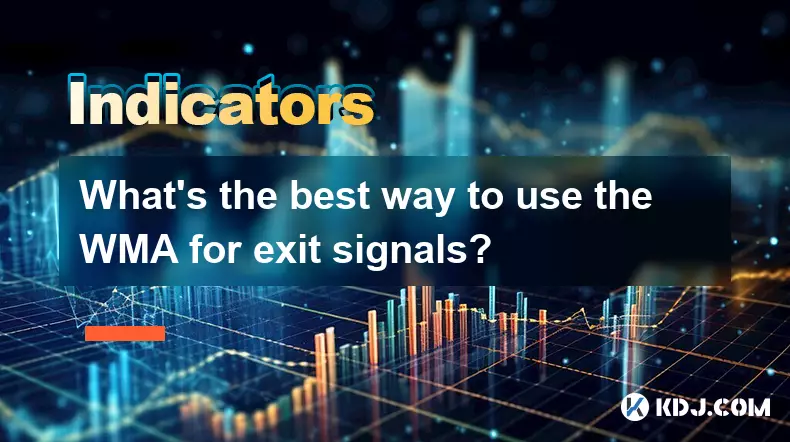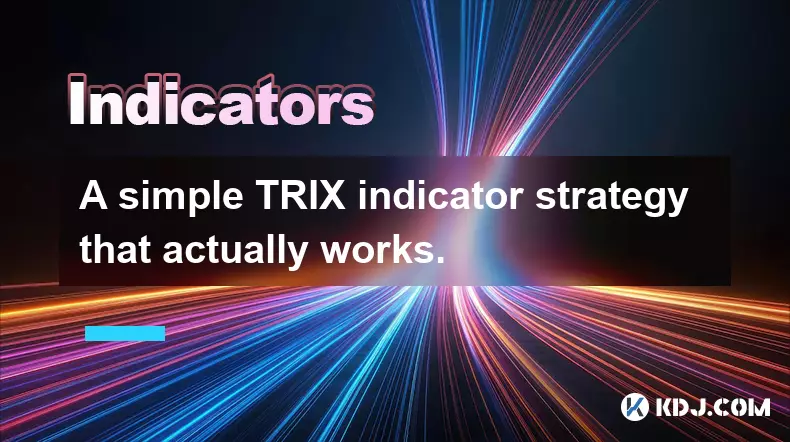-
 bitcoin
bitcoin $102877.190955 USD
1.88% -
 ethereum
ethereum $3430.435064 USD
4.52% -
 tether
tether $0.999264 USD
-0.05% -
 xrp
xrp $2.307310 USD
4.49% -
 bnb
bnb $987.740692 USD
3.82% -
 solana
solana $161.947760 USD
3.97% -
 usd-coin
usd-coin $0.999712 USD
-0.05% -
 tron
tron $0.292810 USD
2.93% -
 dogecoin
dogecoin $0.179738 USD
10.70% -
 cardano
cardano $0.580716 USD
8.75% -
 hyperliquid
hyperliquid $42.463448 USD
8.40% -
 chainlink
chainlink $15.763437 USD
7.05% -
 zcash
zcash $649.595636 USD
17.21% -
 bitcoin-cash
bitcoin-cash $511.610261 USD
7.19% -
 stellar
stellar $0.292537 USD
7.91%
What's the best way to use the WMA for exit signals?
The Weighted Moving Average (WMA) enhances crypto trading exits by prioritizing recent prices, offering timely signals through slope changes, crossovers, and confluence with RSI or MACD.
Oct 21, 2025 at 10:37 am

Understanding the Weighted Moving Average in Crypto Trading
1. The Weighted Moving Average (WMA) assigns greater importance to recent price data, making it more responsive to new information compared to simple moving averages. This sensitivity is particularly useful in the fast-moving cryptocurrency markets where delays can lead to missed opportunities or increased risk exposure.
2. Traders use WMA lines as dynamic support and resistance levels. When the price moves significantly away from the WMA, it may signal overextension, suggesting a potential reversal point to close a position. A sharp deviation above or below the WMA often precedes pullbacks, especially during volatile periods common in digital asset trading.
3. One effective exit strategy involves monitoring the angle and slope of the WMA. A flattening or reversing trajectory indicates weakening momentum. When the upward incline begins to level out or turn downward in an uptrend, it serves as an early warning that bullish energy is fading, prompting traders to consider closing long positions.
4. Combining WMA with volume analysis enhances exit precision. If price action shows signs of stalling near the WMA and trading volume starts to decline, it suggests diminishing interest. This divergence between price and volume reinforces the decision to exit before a broader reversal takes hold.
5. In ranging markets, exits can be timed when price reaches the upper or lower boundary defined by dual WMA bands. For instance, selling near the upper WMA band in a sideways channel prevents holding through mean reversion. This method works well for altcoins stuck in consolidation phases.
Combining WMA with Momentum Indicators for Precision Exits
1. Pairing the WMA with oscillators like the Relative Strength Index (RSI) improves exit accuracy. When price touches or slightly exceeds the WMA while RSI enters overbought territory (>70), it signals exhaustion. This confluence strengthens the case for closing long trades.
2. Similarly, in downtrends, if price approaches the WMA from below and RSI reflects oversold conditions (
3. The MACD histogram’s contraction while price interacts with the WMA offers another layer of confirmation. Shrinking bars on the MACD indicate deceleration in trend strength. When this occurs near the WMA, it highlights a high-probability zone to exit existing positions.
4. Stochastic indicators crossing within the overbought or oversold zones at WMA touchpoints provide timely alerts. A bearish crossover near the WMA during an uptrend warns that upward thrust is ending. This setup is frequently observed in Bitcoin after parabolic rallies.
5. Divergence between price making new highs and the WMA failing to rise accordingly suggests underlying weakness. Such structural discrepancies often precede exits initiated by institutional players who rely on smoothed price representations.
Practical Exit Tactics Using WMA Crossovers
1. A shorter-period WMA crossing below a longer-period WMA can serve as a definitive exit trigger. For example, a 10-day WMA dipping under a 30-day WMA in daily charts signals deteriorating near-term momentum, advising liquidation of open longs.
2. Traders employing pyramiding strategies can use sequential WMA breaches to scale out of positions incrementally. Exiting 30% of holdings at the first cross, another 30% at a confirmed close beyond the WMA, and the remainder on volume spike ensures partial profit capture while maintaining exposure to continued trends.
3. In highly leveraged futures trading, maintaining a running stop-loss just below the rising WMA protects gains. If price violates this level decisively, automatic execution removes the trader from the position before emotional hesitation leads to larger losses.
4. During news-driven spikes, price may briefly pierce the WMA only to snap back. Waiting for two consecutive closes beyond the WMA filter false breakouts. This rule reduces premature exits triggered by whale-induced volatility or exchange-specific anomalies.
5. On lower timeframes like 15-minute or hourly charts, intraday traders utilize WMA crossovers in conjunction with key Fibonacci retracement levels. An exit executed at the intersection of 61.8% retracement and WMA rejection has shown consistent results across major crypto pairs.
Frequently Asked Questions
How does WMA differ from EMA in generating exit signals?While both emphasize recent prices, WMA applies a linear weighting scheme, giving the most recent data the highest multiplier. EMA uses exponential smoothing, which reacts faster but may produce more whipsaws. In choppy crypto markets, WMA tends to generate fewer false exits due to its structured weighting approach.
Can WMA be used effectively in bear markets?Yes. In declining markets, the WMA often acts as a resistance ceiling. Short positions can be held until price approaches the WMA and shows rejection patterns like long upper wicks or cluster of red candles. Closing shorts near these zones avoids being caught in counter-trend bounces.
What timeframes work best with WMA-based exit strategies?Daily and 4-hour charts offer optimal balance between noise reduction and responsiveness. On shorter frames like 5-minute, WMA signals become overly sensitive, increasing the risk of premature exits. Weekly WMAs are too slow for active crypto traders managing leveraged positions.
Is WMA suitable for automated trading bots?Absolutely. Its mathematical clarity allows straightforward coding into algorithmic systems. Bots can be programmed to monitor WMA slope changes, crossovers, and price-WMA distance thresholds to execute exits without human intervention, ensuring discipline during high-volatility events.
Disclaimer:info@kdj.com
The information provided is not trading advice. kdj.com does not assume any responsibility for any investments made based on the information provided in this article. Cryptocurrencies are highly volatile and it is highly recommended that you invest with caution after thorough research!
If you believe that the content used on this website infringes your copyright, please contact us immediately (info@kdj.com) and we will delete it promptly.
- Ripple (XRP) in 2026: Hold or Fold? A Look at XRP's Future and Emerging DeFi Alternatives
- 2025-11-08 18:35:01
- Zcash ZEC Coin Price Explosion: From Privacy Niche to Center Stage
- 2025-11-08 18:55:01
- Berachain Price Prediction: Navigating the Honeycomb Hype in Crypto
- 2025-11-08 18:55:01
- Arthur Hayes, Gold, and Bitcoin: A Modern Monetary Trinity?
- 2025-11-08 19:15:01
- Shiba Inu's Next Move: Navigating a Shifting Market
- 2025-11-08 19:20:01
- Pakistan's Crypto Crossroads: Balancing Opportunity with Asset-Backed Realities
- 2025-11-08 19:20:01
Related knowledge

How do professional traders use the TRIX indicator?
Nov 06,2025 at 04:40pm
Understanding the TRIX Indicator in Crypto TradingThe TRIX (Triple Exponential Average) indicator is a momentum oscillator used by professional trader...

Can I use the TRIX indicator on my mobile trading app?
Nov 07,2025 at 07:40pm
The TRIX indicator, a momentum oscillator designed to filter out short-term fluctuations and highlight long-term trends, has become increasingly popul...

How to code a simple TRIX indicator script in Pine Script?
Nov 07,2025 at 06:20am
How to Code a Simple TRIX Indicator in Pine Script The TRIX (Triple Exponential Moving Average) indicator is widely used in cryptocurrency trading to ...

A simple TRIX indicator strategy that actually works.
Nov 08,2025 at 05:39pm
Understanding the TRIX Indicator in Crypto Trading1. The TRIX (Triple Exponential Average) indicator is a momentum oscillator designed to filter out s...

How to trade TRIX indicator signals on the 1-hour chart?
Nov 07,2025 at 05:39am
Bitcoin's Role in Decentralized Finance1. Bitcoin remains the cornerstone of decentralized finance, serving as a benchmark for value and security acro...

Can the TRIX indicator be used for long-term investing?
Nov 06,2025 at 02:19pm
Understanding the TRIX Indicator in Cryptocurrency Markets1. The TRIX (Triple Exponential Average) indicator is a momentum oscillator designed to filt...

How do professional traders use the TRIX indicator?
Nov 06,2025 at 04:40pm
Understanding the TRIX Indicator in Crypto TradingThe TRIX (Triple Exponential Average) indicator is a momentum oscillator used by professional trader...

Can I use the TRIX indicator on my mobile trading app?
Nov 07,2025 at 07:40pm
The TRIX indicator, a momentum oscillator designed to filter out short-term fluctuations and highlight long-term trends, has become increasingly popul...

How to code a simple TRIX indicator script in Pine Script?
Nov 07,2025 at 06:20am
How to Code a Simple TRIX Indicator in Pine Script The TRIX (Triple Exponential Moving Average) indicator is widely used in cryptocurrency trading to ...

A simple TRIX indicator strategy that actually works.
Nov 08,2025 at 05:39pm
Understanding the TRIX Indicator in Crypto Trading1. The TRIX (Triple Exponential Average) indicator is a momentum oscillator designed to filter out s...

How to trade TRIX indicator signals on the 1-hour chart?
Nov 07,2025 at 05:39am
Bitcoin's Role in Decentralized Finance1. Bitcoin remains the cornerstone of decentralized finance, serving as a benchmark for value and security acro...

Can the TRIX indicator be used for long-term investing?
Nov 06,2025 at 02:19pm
Understanding the TRIX Indicator in Cryptocurrency Markets1. The TRIX (Triple Exponential Average) indicator is a momentum oscillator designed to filt...
See all articles





















![The Graph Price Prediction [GRT Crypto Price News Today] The Graph Price Prediction [GRT Crypto Price News Today]](/uploads/2025/11/07/cryptocurrencies-news/videos/690d4df44fe69_image_500_375.webp)



















































